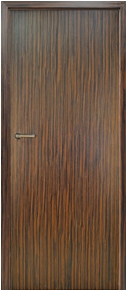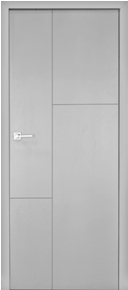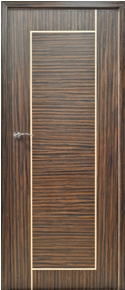Designing Internal Doors – practical advice for homeowners and interior designers
So you don’t like designs of any readily available internal doors or perhaps you would rather have your own unique design of doors. That’s great! We believe that doors can significantly transform your living environment and should reflect the personality of the homeowners as much as compliment the interior design of the property. If the budget allows for it, you can create your own bespoke door design inch by inch, choosing the colour, finish and design features that suit you.
Colours
This is where everything starts and the possibilities are literally endless here. You will have to decide whether to choose a colour matching to other parts of your interiors – floors, walls, furniture etc. or whether to contrast the doors. Also, when you think of doors, you have to consider the surround features such as frames, architraves and skirting boards – should they match the doors or create a contrast? Whichever idea suits your property more, there are many available options:
– Solid colours – have the doors painted in any of the RAL or BS colours (nearly 2000 shades of colours) or to match paint samples from Dulux, Farrell & Ball etc. This is particularly useful for very modern interiors, blending in or contrasting with walls, furniture or artificial flooring (tiles, vinyl and carpet).
– Wood – choosing a natural timber for your doors will give you a natural colour and wood grain variation, making each door unique and adding extra character to the property. Thankfully, due to the door industry using thin wood veneers rather than solid wood – the choice of available wood colours is quite extensive. Even the hardest and most difficult to work with exotic timbers such wenge or ebony in the form of a thin veneer can be used on an internal door face with less cost implication as well as the popular American/European Oak or American Black Walnut. As well as this you can adjust the natural timber colour further with the use of wood stains, so you could have an oak door stained dark to a wenge colour or white washed to match some of the modern wood floorings.
– Artificial – there is a huge range of laminates and artificial wood veneers to choose from. Laminates are available in solid colours, metallic or with printed patterns. They are great for mixing different colours and patterns into funky, contemporary door designs. The artificial (man-made) veneers are generally made to resemble natural wood veneers offering a cheaper alternative to some expensive, exotic veneers. Also, because they are artificial, there is no natural colour or grain variation, so they are also used to produce completely identical doors for the whole property without losing the wood effect. Recently, artificial wood veneers in unusual colours, such as shades of grey or black have become increasingly popular. The look and feel of timber is preserved, however the colour can be completely unusual to match other features of the interiors.
Design Features
Once you have decided on the colour composition, it’s time to think about the actual design of the door. There are quite a few features available but there are also some technical limitations and it’s probably best to speak to a specialist at this stage to make sure your ideas are physically possible to achieve. The most common design features are:
– Glass (vision) panels – you can choose one or many vision panels in different shapes and sizes and use glass of your choice in them – clear, frosted or with unique decorative pattern. Glass panels apart from being a great design feature also offer very important functionality – they help create the optimal light flow in the property, lighting up darker rooms. Aside from glass, the vision panels usually include glazing beads surrounding the glass, and these can be produced in a number of styles such as decorative mouldings, flat protruding beads, quirk type flush shadow gap beads or no beads at all (glass inserted directly into a door core).
– Veneer patterns – there are two most common ways of slicing veneer – crown cut and quarter cut. They produce completely different wood grain patterns and that alone is often used as a design feature. The composition of cross directional wood veneers on a door is very popular and can create a simple but elegant door design.
– Grooves – the composition of grooves adds style and character to the door. This feature offers great design flexibility – you can choose straight or curved lines, different width and depth as well as creating a variety of shapes. Please note that grooves on wood veneered surfaces often require additional timber inserts into the door core and therefore there is a limitation on the size and number of grooves that can be used on fire resistant doors.
– Inlays – strips of wood veneers or metallic laminates, usually contrasting in colour to the rest of the door. Similarly to grooves they can be laid into compositions of straight lines and shapes, but the entire door surface will remain flat and easy to keep clean.
Finishes
Wood needs protection and so do wooden doors. There is a number of products such as paints, stains, oils and varnishes (lacquers) that can be used as a top layer on wooden doors for protection from moisture and discolouration. In fact clear UV lacquers are often used on top of already painted or stained doors for extra protection.
Lacquers and paints can be made with different levels of sheen, determining how shiny the door surface appears, ranging from 10% (matt) to 90% (ultra high gloss). 20-30% satin finishes are the most popular, followed by semi-gloss (30-40%) and gloss (40-60%). Higher sheen levels are not readily available and require special procedures involving multiple applications, sanding and polishing in a controlled environment – this takes longer to accomplish and adds significantly higher cost, however, as a result you could achieve up to a 90% gloss level, similar to a “piano finish”.
So once you have designed your unique custom internal door it’s time to decorate it with the right choice of ironmongery – handles or knobs, hinges, locks etc. Simplistic designs should have simplistic door furniture, however completely plain doors will look better with a choice of original designer style ironmongery.
At Modern Doors we don’t only design and produce bespoke doors to your exact requirements. We also provide an extensive design consultation and we will even provide a sample made with the chosen colour, finish and design feature if this is required prior to manufacture. That way you are in full control of every detail of your very own designer doors.





Replica Oakleys
Hi! Do you use Twitter? I’d like to follow you if that would be okay. I’m undoubtedly enjoying your blog and look forward to new updates.
Yes, you can find us on Twitter at https://twitter.com/ModernDoorsLtd or @ModernDoorsLtd